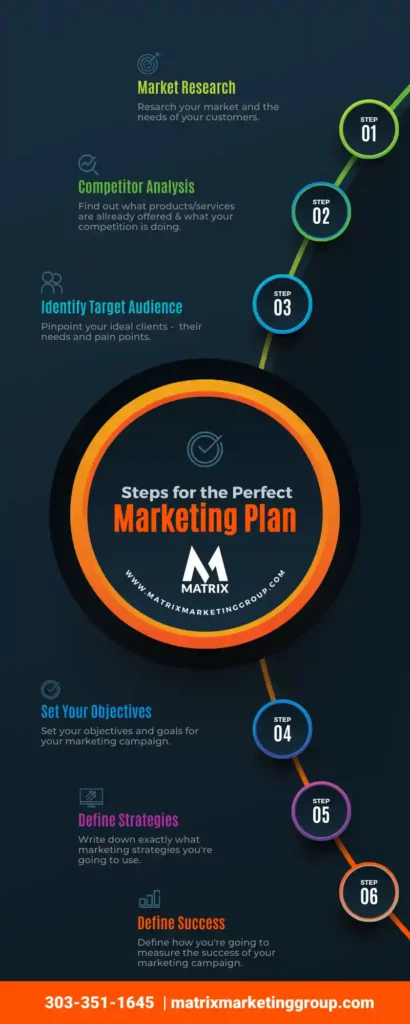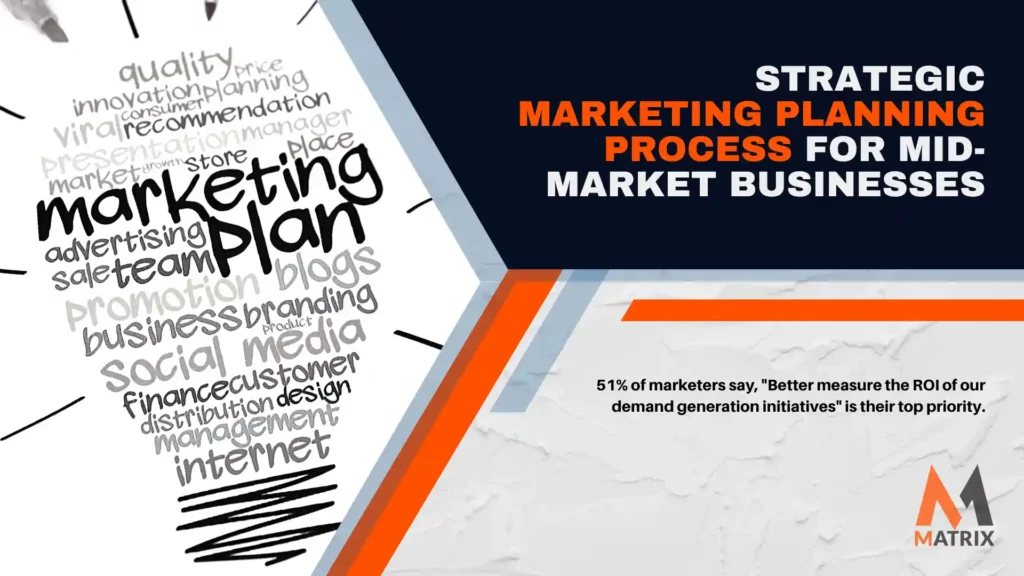Strategic Marketing Planning Process for Mid-market Businesses
Mid-market businesses need a solid strategic marketing planning process.
Mid-market businesses with annual revenues of $10 million to $1 billion often find themselves in a difficult position in strategic planning.
The meaning of strategic marketing planning is wide and deep. Here is where your strategic marketing planning can help you win or lose.
They are too small to afford the high-end consulting and research firms like McKinsey or BCG that can help them develop a comprehensive plan, but they are too large to rely on the seat-of-the-pants approach that may have worked for them in the past.
Middle-market businesses have entered into another business phase. With a smaller budget and fewer resources, mid-market firms have different requirements than larger enterprises.
Low cost, quick implementation, and quality of services and support are the top priorities in the mid-market.
They need help but need the following high-level requirements.
- Affordability
- Quick ROI
- World-class service and support
There is a process that these businesses can use. However, that will allow them to develop a plan tailored to their needs and resources.
This process begins with assessing the current market situation and evaluating the company’s strengths and weaknesses. Specific goals can be set, and strategies can be devised to achieve them. The final step is the implementation and tracking of results.
An effective strategic marketing planning process is key for mid-market businesses to succeed.

Considering the company’s strengths and weaknesses, these businesses can set achievable goals and create strategies to achieve them. The implementation and tracking of results are also crucial to ensure the plan is successful.
How can the CMO do a better job with the strategic marketing planning process?

The CMO can do a better job with the strategic marketing planning process by ensuring that all stakeholders are involved and that the plan is tailored to the company’s specific needs.
The CMO should also ensure that the plan is implemented and tracked effectively to achieve the desired results.
What are some common mistakes that mid-market businesses make regarding marketing planning?
Some common mistakes that mid-market businesses make when it comes to marketing planning include failing to involve all stakeholders, not tailoring the plan to the company’s specific needs, and not implementing or tracking the plan effectively.
How can mid-market businesses avoid these mistakes?
Mid-market businesses can avoid these mistakes by following a few simple steps: ensure that all stakeholders are involved in the planning process, tailor the plan to the company’s specific needs, and implement and track the plan effectively.
- The first step is ensuring that all stakeholders are involved in strategic marketing planning. This includes the CMO, marketing, sales, and other relevant departments. All stakeholders should clearly understand the company’s goals and objectives.
- The second step is to tailor the plan to the company’s specific needs. The strategic marketing planning process should be flexible enough to accommodate the unique needs of each business.
- Finally, mid-market businesses must implement and track the plan to ensure its success. This includes setting milestones and measuring progress against them. It is also important to have a system to track results to make adjustments as needed.
Regarding planning, what are some best practices that mid-market businesses should follow?
Some best practices that mid-market businesses should follow for strategic marketing planning include involving all stakeholders, tailoring the plan to the company’s specific needs, setting achievable goals, and tracking and measuring progress.
Metrics for the Strategic Marketing Planning Process
There are a variety of metrics that can be used to measure the progress of a marketing plan. Common metrics include website traffic, generated leads, conversion, and customer retention rates. It is important to select the right metrics-based plan’s specific goals plan.
3 key Benchmark metrics for the top of the sales funnel

- Conversion Rate: This is the percentage of leads that result in a sale. It’s important to track this metric to identify where your sales process is breaking down and make necessary improvements.
- Average Sale Price: This measures how much money you make from each sale. Knowing this number can help determine whether you need to focus on increasing your conversion rate or average sale price.
- Average Time to Convert: This measures how long it takes, on average, for a lead to convert into a sale. Tracking this metric can help you identify bottlenecks in your sales process and make necessary adjustments.
3 key Benchmark metrics for the middle of the funnel (MOF)
Task throughput, latency, and jitter are the key metrics for MOF. Throughput is how many messages can be processed in a given period.
Latency is the time it takes for a message to be processed. Jitter is the variation in latency from one message to the next.
3 key Benchmark metrics for the bottom of the sales funnel
Key benchmark metrics at the bottom of the sales metrics include conversion rate, average order value, and customer lifetime value.
Conversion rate is the percentage of visitors who complete the desired action, such as purchasing. Average order value is the amount customers spend in a given transaction.
Customer lifetime value is the total amount customers are expected to spend throughout their relationship with a company.
I look at the process from 30,000 feet, including strategy, people, processes, and technology. Now, dive down to 15,000 feet and look at your sales channels. Where are sales coming from and expected with lift?
Do a gap analysis on your sales, marketing, and customer services functions. Remember the 80/20 rule? Apply it here and get to work. Still confused? Give us a call.
Understanding business strategy and competitive advantage is important for strategic marketing planning for small and mid-sized businesses. Marketing management needs to be involved in the business planning process in three important ways:
- They participate in strategic analysis and planning for the business.
- They serve with other functional managers as business unit strategic planning team members.
- They develop and implement strategic marketing plans for the market served by the company. This article will discuss strategic marketing and the strategic marketing planning process for developing, implementing, and managing your marketing strategy.
Strategic Marketing Planning

The chief marketing executive’s strategic planning responsibility includes:
- Participating in the company’s strategy formulation.
- Developing marketing strategies for the company’s business goals.
Since these two areas are closely interrelated, examining marketing’s role and functions is important to gain insight into marketing’s responsibilities and contributions.
Marketing cannot be a separate function within the business, on par with others. Marketing requires separate work and a group of activities. It is an essential dimension of the entire business. The whole business is seen from the point of view, from the customer’s point of view.
This description of marketing’s role in the company can be combined with a traditional view of marketing management to define strategic marketing as a process consisting of:
- Analyzing environmental, market, competitive, and business factors affecting the corporation and its business units; identifying market opportunities and threats; forecasting future trends in business areas of interest to the company. And participating in setting objectives and formulating company and business unit strategies.
- Selecting target market strategies for the product markets in each business unit, establishing marketing objectives, and developing, implementing, and managing the marketing program positioning strategies to meet target market needs.
Looking at several key characteristics of strategic marketing reveals its nature and scope.
Here are some examples of the strategic planning process.
Characteristics of Strategic Marketing
Traditional marketing management concentrates on product, distribution, price, and promotion strategies.
Strategic marketing includes strategies and marketing budgets and incorporates important strategic considerations outside the domain of marketing management. Strategic marketing follows a market-driven process of strategy development.
This requires you to consider a constantly changing business environment and a continual requirement to deliver customer satisfaction. Strategic marketing focuses on financial performance rather than marketing’s traditional concern about increasing sales.
Market-Driven Strategies. Competitive advantage is customer-driven and focused on the target audience. This is based on (1) the degree of customer satisfaction achieved by the company and (2) the extent to which the company exceeds the customer satisfaction levels of the competition.
Marketing strategy contributes to competitive advantage by combining the customer-influencing strategies of the business into an integrated array of market-focused actions. Strategic marketing includes the actions of the business to provide customer satisfaction.

Strategy development considers business scope, competitive advantage, and organizational effectiveness. Customer targeting and assembling the company’s marketing program are coordinated among the functions within the business.
Content Marketing for Construction Companies: 5 Easy Steps to More Projects
Strategic marketing provides the companies linked with the environment and emphasizes marketing as an integrated responsibility of the business rather than a specialized function. Achieving competitive advantage requires teamwork and functional integration.
Environmental External forces all through the composition and attractiveness of markets and the competitive structure it presents in markets.
The turbulence in today’s business environment emphasizes strategic marketing, the target market, and competitor monitoring capabilities. I will highlight the importance of effective strategic management processes in rapidly changing business environments.
Because of marketing’s boundary orientation between the company and its customers, channel members, and competition, the function is central to the strategic planning process.
Strategic marketing provides the expertise for environmental monitoring, deciding which customer groups to serve product specifications and which competitors to position against.
Marketing executives provide the professional skills and experience needed to meet these responsibilities. In addition, it is important to recognize the company strategies involved in integrating marketing and other functional strategies.
Successfully integrating multifunctional strategies is critical to providing high levels of customer satisfaction.
Customer Satisfaction. The key to customer satisfaction is linking buyers’ needs with the company’s product and/or service planning process.
Customer preferences for product attributes must be transformed into product design and production guides. Marketing professionals have the experience and skills to analyze customer satisfaction with surveys and net promoter scores (NPS).
Financial Performance. Finally, strategic marketing moves beyond our revenue emphasis on marketing management. Instead, the objective is to make strategic marketing decisions that contribute to the business’s financial performance.
Return on investment (ROI) replaces sales as the basis for guiding marketing decisions. Strategic choices, such as which markets to enter or exit, are guided by estimated financial performance using the same criteria in the time horizon to gauge business success. Several basic financial analysis concepts and methods are needed for these actions.
Corporate and Business Unit Plans (SBU)

Before starting a marketing strategy, management must clearly understand its objectives and plans for each SBU.
Within the guidelines of the business mission and objectives, the strategy selected for each business unit has an important bearing on the marketing plan and other functional plans such as operations, finance, and human resources.
Understanding the business purpose, scope, objectives, and strategy is essential to making strategic marketing decisions corresponding to the corporate and business unit plan.
Top management must answer these questions. Based on assessing the business unit’s strength in attractiveness, what broad strategy will the unit pursue, and what financial resources will be available to carry out the strategies?
Will the unit be managed for cash flow, growth, or earnings?
Second, what are the expectations of top management regarding sales, market share, profit contribution, and other aspects of performance?
These guidelines provide the basis for developing SBU and marketing strategies.
Strategic priorities for SBUs should be set by the management team for each business unit, working closely with the executives responsible for corporate strategy.
For example, participation by key executives is essential in determining sales and market share targets for a business unit. Moreover, some negotiation flexibility may be necessary to motivate managers and allow them to execute strategies with a high probability of success.
Strategic Marketing Planning Process
The strategic marketing planning process was used.
The situation analysis considers market structure and supply and demand, market segmentation, customer analysis, and competitor analysis.
Marketing strategy design examines marketing advantage, customer targeting, positioning analysis, strategy selection for different situations, and the new product strategy.
Marketing program development selects the product, distribution, price, and promotion strategies that correspond to the needs of targeted buyers.
Strategy implementation and management consider organizational design and effectiveness, marketing strategy implementation and control, and the strategic role of information. Each stage of the strategy process will be examined in a future post. So stay tuned.
Wrapping Up
Marketing strategy is an analysis, planning, implementation, and control process designed to satisfy customer needs and wants. The process starts with an understanding of the corporate mission statement and the strategy of each strategic business unit.
Strategic marketing is organized around the strategic marketing planning process. Product market analysis, market segmentation, and competition analysis are important for strategic planning. These analyses guide the choice of marketing strategy.
Market definition establishes the overall competitive arena. Market segmentation identifies and analyzes the alternative customer group for targeting by the company. Competitor analysis examines the strengths, weaknesses, and strategies of key competitors.
When was the last time you and your organization reviewed your marketing strategy and how it stacks up to your competitors?
Want to add to the conversation? Go here @mmgtweets. And don’t forget to share this article with a friend.
FAQs about Strategic Marketing Planning Process for Mid-Market Businesses
What is the goal of the strategic marketing planning process?

The strategic marketing process aims to develop a plan to help a company achieve its desired results. This includes setting goals, developing strategies, and implementing and tracking the plan.
What are some common metrics that can measure progress?

Common progress metrics include website traffic leads, conversion, and customer retention rates. Selecting the right metrics based on the plan’s specific goals is important.
How long should it take to complete the strategic marketing planning process?

The strategic marketing planning process should take about 3-6 months. This timeline can vary depending on the size and complexity of the company.
How often should the plan be updated?

The plan should be updated regularly, at least once per quarter. This will ensure that the plan is on track and meeting its objectives. It may also be necessary to adjust the plan based on new information or changes in the market.

